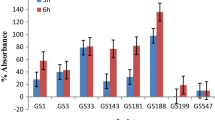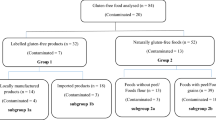Abstract
To date, the only acceptable therapeutic approach for celiac disease (CD) is a strict elimination from the diet of gluten-containing foods, but this diet does not always guarantee an adequate nutritional intake. Pseudocereals are receiving considerable attention as interesting alternatives for the formulation of gluten-free products, and quinoa grains arise as nutritive substitutes of conventional cereals. The aim of this study was the characterization of different quinoa samples corresponding to 11 quinoa varieties, using polyacrylamide gel electrophoresis in the presence of sodium dodecyl sulfate (SDS-PAGE) and immunoblotting techniques to assess their suitability for celiac subjects. Some of these varieties were grown in Italy to assess if the reproduction in a new habitat can guarantee the retention of the “safe” protein pattern. None of the quinoa varieties studied presented protein bands with electrophoretic mobility comparable with those of wheat gliadins, the toxic protein for celiac subjects. All the quinoa samples showed a low binding affinity for both specific anti-gliadin antibodies and IgAs from celiac subjects, confirming that quinoa can be considered as a safe ingredient for celiac patients. However, reliable varieties should be previously selected since the immuno cross-reactivity with anti-gliadin antibodies can vary significantly.




Similar content being viewed by others
Abbreviations
- BCIP/NBT:
-
Bromochloroindolyl phosphate-nitroblue tetrazolium
- CD:
-
Celiac disease
- GFD:
-
Gluten-free diet
- PVDF:
-
Polyvinylidene difluoride
- SDS-PAGE:
-
Polyacrylamide gel electrophoresis in the presence of sodium dodecyl sulfate
- TEMED:
-
N,N,N′,N′-tetramethylenediamine.
References
Lohi S, Mustalahti K, Kaukinen K, Laurila K, Collin P, Rissanen H, Lohi O, Bravi E, Gasparin M, Reunanen A, Maki M (2007) Increasing prevalence of celiac disease over time. Aliment Pharmacol Ther 26:1217–1225. doi:10.1111/j.1365-2036.2007.03502.x
Catassi C, Fasano A (2008) Celiac disease. In: Arendt EK, Dal Bello F (eds) Gluten-free cereal products and beverages. Academic, London
Hallert C, Grant C, Grehn S, Grännö C, Hultén S, Midhagen G, Ström M, Svensson H, Valdimarsson T (2002) Evidence of poor vitamin status in coeliac patients on a gluten-free diet for 10 years. Aliment Pharmacol Ther 16:1333–1339. doi:10.1046/j.1365-2036.2002.01283.x
Miranda J, Lasa A, Bustamante MA, Churruca I, Simon E (2014) Nutritional differences between a gluten-free diet and a diet containing equivalent products with gluten. Plant Foods Hum Nutr 69:182–187. doi:10.1007/s11130-014-0410-4
Thompson T (1999) Thiamin, riboflavin, and niacin contents of the gluten-free diet: is there cause for concern? J Am Diet Assoc 99:858–862. doi:10.1016/S0002-8223(99)00205-9
Kinsey L, Burden ST, Bannerman EA (2008) Dietary survey to determine if patients with coeliac disease are meeting current healthy eating guidelines and how their diet compares to that of the British general population. Eur J Clin Nutr 62:1333–1342. doi:10.1038/sj.ejcn.1602856
Thompson T, Dennis M, Higgins LA, Lee AR, Sharrett MK (2005) Gluten-free diet survey: are Americans with coeliac disease consuming recommended amounts of fibre, iron, calcium and grain foods? J Hum Nutr Diet 18:163–169. doi:10.1111/j.1365-277X.2005.00607.x
Wild D, Robins GG, Burley VJ, Howdle PD (2010) Evidence of high sugar intake, and low fibre and mineral intake, in the gluten-free diet. Aliment Pharmacol Ther 32:573–581. doi:10.1111/j.1365-2036.2010.04386.x
Mariani P, Viti MG, Montuori M, La Vecchia A, Cipolletta E, Calvani L, Bonamico M (1998) The gluten-free diet: a nutritional risk factor for adolescents with celiac disease? J Pediatr Gastroenterol Nutr 27:519–523. doi:10.1097/00005176-199811000-00004
Hopman EG, le Cessie S, von Blomberg BM, Mearin ML (2006) Nutritional management of the gluten-free diet in young people with celiac disease in The Netherlands. J Pediatr Gastroenterol Nutr 43:102–108. doi:10.1097/01.mpg.0000228102.89454.eb
Lucisano M, Cappa C, Fongaro L, Mariotti M (2012) Characterisation of gluten-free pasta through conventional and innovative methods: evaluation of the cooking behaviour. J Cereal Sci 56:667–675. doi:10.1016/j.jcs.2012.08.014
Alvarez-Jubete L, Arendt EK, Gallagher E (2009) Nutritive value and chemical composition of pseudocereals as gluten-free ingredients. Int J Food Sci Nutr 60:240–257. doi:10.1080/09637480902950597
Ballabio C, Uberti F, Di Lorenzo C, Brandolini A, Peñas E, Restani P (2011) Biochemical and immunochemical characterization of different varieties of amaranth (Amaranthus L. spp) as a safe ingredient for gluten-free products. J Agric Food Chem 59:12969–12974. doi:10.1021/jf2041824
Repo-Carrasco R, Espinoza C, Jacobsen SE (2003) Nutritional value and use of the Andean crops quinoa (Chenopodium quinoa) and kañiwa (Chenopodium pallidicaule). Food Rev Int 19:179–189. doi:10.1081/FRI-120018884
Abugoch L, Romero N, Tapia C, Silva J, Rivera M (2008) Study of some physicochemical and functional properties of quinoa (Chenopodium quinoa Willd.) protein isolates. J Agric Food Chem 56:4745–4750. doi:10.1021/jf703689u
Koziol MJ (1992) Chemical composition and nutritional evaluation of quinoa (Chenopodium quinoa Willd.). J Food Comp Anal 5:35–68. doi:10.1016/0889-1575(92)90006-6
Nascimento AC, Mota C, Coelho I, Gueifao S, Santos M, Matos AS, Gimenez A, Lobo M, Samman N, Castanheira I (2014) Characterisation of nutrient profile of quinoa (Chenopodium quinoa), amaranth (Amaranthus caudatus), and purple corn (Zea mays L.) consumed in the North of Argentina: proximates, minerals and trace elements. Food Chem 148:420–426. doi:10.1016/j.foodchem.2013.09.155
Stikic R, Glamoclija D, Demin M, Vucelic-Radovic B, Jovanovic Z, Milojkovic-Opsenica D, Jacobsen S-E, Milovanovic M (2012) Agronomical and nutritional evaluation of quinoa seeds (Chenopodium quinoa Willd.) as an ingredient in bread formulations. J Cereal Sci 55:132–138. doi:10.1016/j.jcs.2011.10.010
Drzewiecki J, Delgado-Licon E, Haruenkit R, Pawelzik E, Martin-Belloso O, Park Y-S, Jung S-T, Trakhtenberg S, Gorinstein S (2003) Identification and differences of total proteins and their soluble fractions in some pseudocereals based on electrophoretic patterns. J Agric Food Chem 51:7798–7804. doi:10.1021/jf030322x
Coda R, Rizzello CG, Gobbetti M (2010) Use of sourdough fermentation and pseudo-cereals and leguminous flours for the making of a functional bread enriched of γ-aminobutyric acid (GABA). J Food Microbiol 137:236–245. doi:10.1016/j.ijfoodmicro.2009.12.010
Schoenlechner R, Drausinger J, Ottenschlaeger V, Jurackova K, Berghofer E (2011) Functional properties of gluten-free pasta produced from amaranth, quinoa and buckwheat. Plant Foods Hum Nutr 65:339–349. doi:10.1007/s11130-010-0194-0
Mastromatteo M, Chillo S, Iannetti M, Civica V, Del Nobile MA (2011) Formulation optimisation of gluten-free functional spaghetti based on quinoa, maize and soy flours. Int J Food Sci Technol 46:1201–1208. doi:10.1111/j.1365-2621.2011.02613.x
Bergamo P, Maurano F, Mazzarella G, Iaquinto G, Vocca I, Rivelli AN, De Falco E, Gianfrani C, Rossi M (2011) Immunological evaluation of the alcohol-soluble protein fraction from gluten-free grains in relation to celiac disease. Mol Nutr Food Res 55:1266–1270. doi:10.1002/mnfr.201100132
Molberg O, McAdam SN, Korner R, Quarsten H, Kristiansen C, Madsen L, Fugger L, Scott H, Norén O, Roepstorff P, Lundin KE, Sjöström H, Sollid LM (1998) Tissue transglutaminase selectively modifies gliadin peptides that are recognized by gut-derived T cells in celiac disease. Nat Med 4:713–717. doi:10.1038/nm0698-713
Vader LW, de Ru A, van der Val Y, Kooy YM, Benckhuijsen W, Mearin ML, Drijfhout JW, van Veelen P, Koning F (2002) Specificity of tissue transglutaminase explains cereal toxicity in celiac disease. J Exp Med 195:643–649. doi:10.1084/jem.20012028
Zevallos VF, Ellis HJ, Suligoj T, Herencia LI, Ciclitira PJ (2012) Variable activation of immune response by quinoa (Chenopodium quinoa Willd.) prolamins in celiac disease. Am J Clin Nutr 96:337–344. doi:10.3945/ajcn.111.030684
Vega-Galvez A, Miranda M, Vergara J, Uribe E, Puente L, Martinez EA (2010) Nutrition facts and functional potencial of quinoa (Chenopodium quinoa willd.), an ancient Andean grain: a review. J Sci Food Agric 90:2541–2547. doi:10.1002/jsfa.4158
Pasko P, Barton H, Zagrodzki P, Gorinstein S, Folta M, Zachwieja Z (2009) Anthocyanins, total polyphenols and antioxidant activity in amaranth and quinoa seeds and sprouts during their growth. Food Chem 115:994–998. doi:10.1016/j.foodchem.2009.01.037
Acknowledgments
This work was partially supported by the Flagship Project “Istituto dell’Alimentazione e della Salute”, Municipality of Milan. We would like to thank the following Donors for graciously providing us the Chenopodium quinoa samples studied: Hohenheim University, Germany; National Agricultural Research Foundation - Fodder Crops and Pasture Institute (NARF-FCPI), Greece; Bundesanstalt für Züchtungforschung an Kulturplanzen (BAZ), Germany; United States Department of Agriculture – North Central Regional Plant Introduction System (USDA-NCRPIS), USA.
Conflict of Interest
The authors claim no conflict of interest.
Author information
Authors and Affiliations
Corresponding author
Rights and permissions
About this article
Cite this article
Peñas, E., Uberti, F., di Lorenzo, C. et al. Biochemical and Immunochemical Evidences Supporting the Inclusion of Quinoa (Chenopodium quinoa Willd.) as a Gluten-free Ingredient. Plant Foods Hum Nutr 69, 297–303 (2014). https://doi.org/10.1007/s11130-014-0449-2
Published:
Issue Date:
DOI: https://doi.org/10.1007/s11130-014-0449-2




